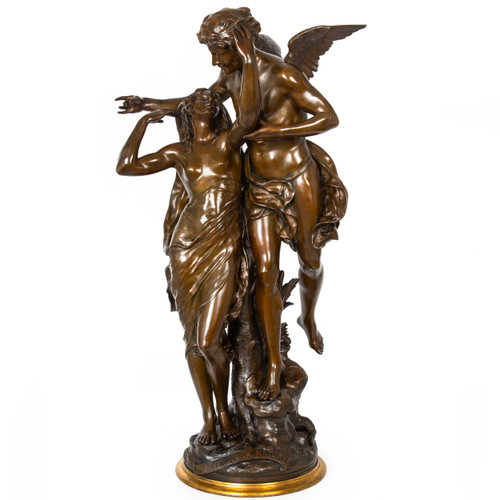catalog text
EMILE PICAULT
French, 1833-1915
"Reveil de la Nature" (The Awakening of Nature)
Sand-cast patinated bronze | signed to naturalistic base "E. PICAULT" with the title of the work embossed across the front | edge of base signed with foundry mark "Boyer Freres à Paris"
Item # 401KUT29V
An exceedingly fine example of Emile Picault's Reveil de la Nature cast by the Boyer foundry in Paris, the sculpture is quite scarce and, unlike most of Picault's work, only shows up on the open-market with great infrequency. The group captures a young woman entirely entranced by Cupid, the mythical young man having touched down beside her with (now missing) a flower in hand. It is an exquisite and ingenious group with a duality of messages, the first layer with this young woman opening her eye to the beauty of nature and seeing the created things around her in a new light, but at the same time is almost certainly allegorical of shedding childhood as the coming of age opens our eyes to an entirely new dimension of the natural world. She suddenly recognizes love and reaches her hand up to touch his face.
Beyond the stunning beauty of the group and the storytelling elements that remain timeless, even presently being prescient and relevant, the work is exceedingly complex and very skillfully executed. It is a showcase of the high level of craftsmanship foundries of the 19th and early 20th century were capable of, the present model executed using dozens of individual components that were perfectly fitted (mostly using roman pins), chased and finished, then tastefully engraved and chiseled prior to finishing in nuanced chemical patina. The endless hours of exhausting work that went into the fabrication of this model is notable.
Standing at just under 35", the group is as substantial as it is powerful. A rare find and an exquisite acquisition.
Measurements: 34 1/2" H x 11 1/2" base diameter
Condition Report: Cupid would have been holding a flower in his outstretched hand at one point, this now absent. Trace discoloration and variation in the patina with rubbing/wear indicators/spots of darker or lighter tarnish, this overall having been cleaned as respectfully as possible before applying a new wax layer; note that there are tiny white specks throughout, some infintesimal while others can be seen - we have removed all of the white specks that were safe and presented no risk to the underlying patina but have left any that we were concerned about. Those can absolutely be remedied, but we were nervous to do any further removal as the risk outweighed any improvement to presentation at that point - if you prefer every white speck removed, contact us for a discussion of this and we can make the necessary arrangements. Ready to place, an exceedingly fine presentation.









































